On Monday morning I was watching the bees feed on the flowers of a black sage plant at the edge of my yard by the road. Two of my neighbors walked by, and one said, “Your plants are beautiful.”
“Thanks!” I said.
Then I thought, The beauty of these plants has nothing to do with me. I don’t even water them. But thanks!
In the summer of 2013, that’s seven years ago now, as soon as my wife and I moved into our house I began planning for a hedge of plants along the road. It is a dirt road, so I wanted dust mitigation. And there were no plants in the yard between our house and the road, so I wanted some privacy. I decided on natives as the type of plants for the roadside.
I wrote a couple posts about this project back in 2015. The first was, “Hedgerow of native plants brings all kinds of benefits.” The second was, “Natives at the roadside.”
Here I’ll look at how things have developed over the last five years and a few of the things I’ve learned along the way.
Positive neighbor attention
One of my favorite things has been the positive reactions of many neighbors. When one of my ceanothus bushes was in full bloom, for example, I had a neighbor stop her car, get out and photograph it. No one is trying to take pictures of my avocado trees or grapevines, but the native ceanothus is a car stopper.
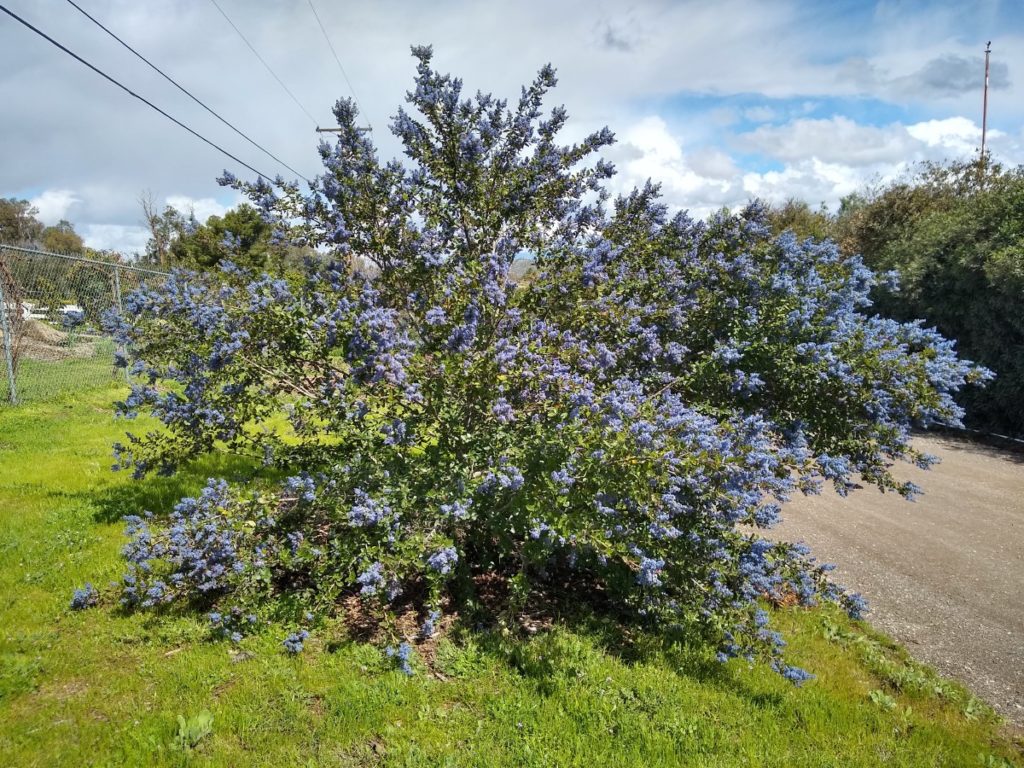
This past winter, another neighbor appreciated my roadside natives enough to help me add to them. He brought me three native plants that he had potted up from his yard: a ceanothus, a scrub oak, and a yellow bush penstemon.

Watering natives
I’ll be giving these new plants water about once per month through the summer until rains start in the fall. That has been my routine for all of the natives I’ve planted by the road during their first year. After their first summer, I cease irrigation. The native plants live on natural rainfall.
But I do usually add extra rainwater each winter from the runoff from my roof. So the plants feel like they’ve gone through a wet winter regardless of how much rain has fallen. This has helped the plants to grow strongly and steadily.
Without any summer irrigation, however, some plants go dull or brownish or even deciduous toward the end of summer, as they do in the wild. I accept that.
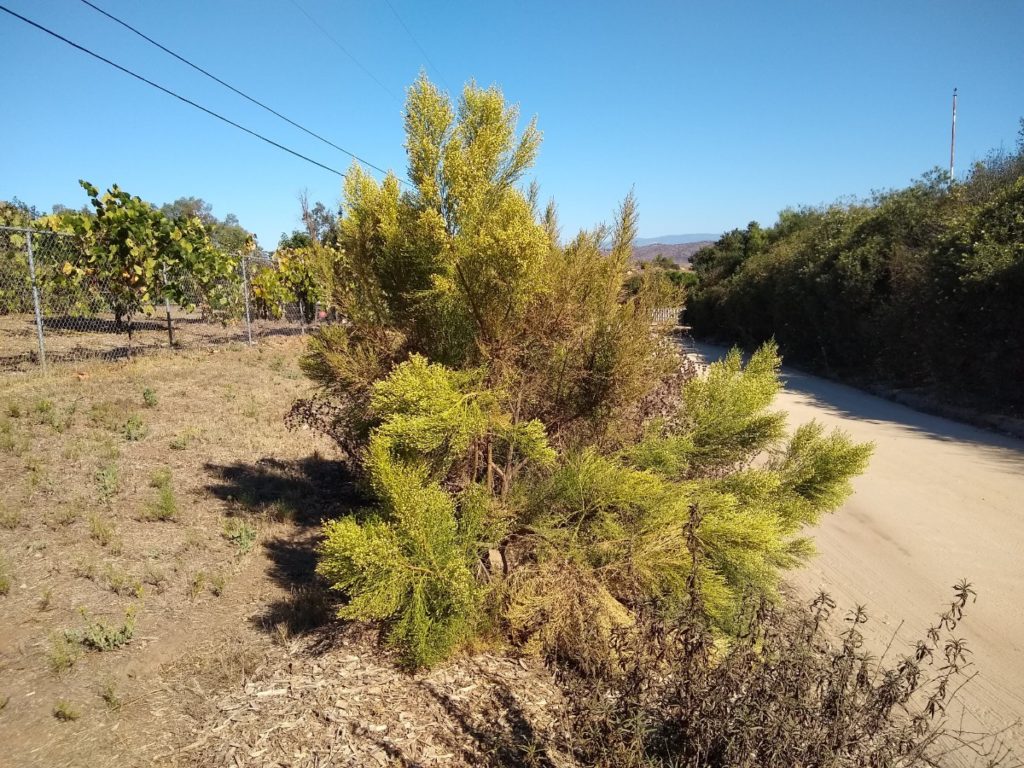

Privacy and dust mitigation
Parts of the yard now have a green buffer from the road and its dust. Instead of watching cars drive by, we get to look at a sugar bush or a coyote bush.

Yet I planted in clusters so there are also open spots remaining, and in some sections the plants are so short that they don’t catch a significant amount of road dust nor provide any privacy yet. The planting continues . . .
Wildlife habitat
Within the clusters of plants that I put in first, the foliage is dense and the plants are mature enough that they are beginning to serve as wildlife habitat. I see lizards hanging out under some, possibly digging burrows there or possibly just waiting to nab a bee to eat.
The birds mostly hang out in my neighbor’s hedge of oleanders and oaks across the road, which is far bigger and denser than my hedge. Then the birds fly across to peck at my apricots — not so welcome — but they also munch on some insects among my fruit trees — welcome.
What I’ve enjoyed the most, though, is the arrival of the bees when each of the native plants is in bloom. Most visited have been the blooms of ceanothus ‘South Coast Blue’ and ‘Ray Hartman’, coyote bush, and black sage. I’ve spotted lots of honeybees, but also natives such as yellow-faced bumblebees.
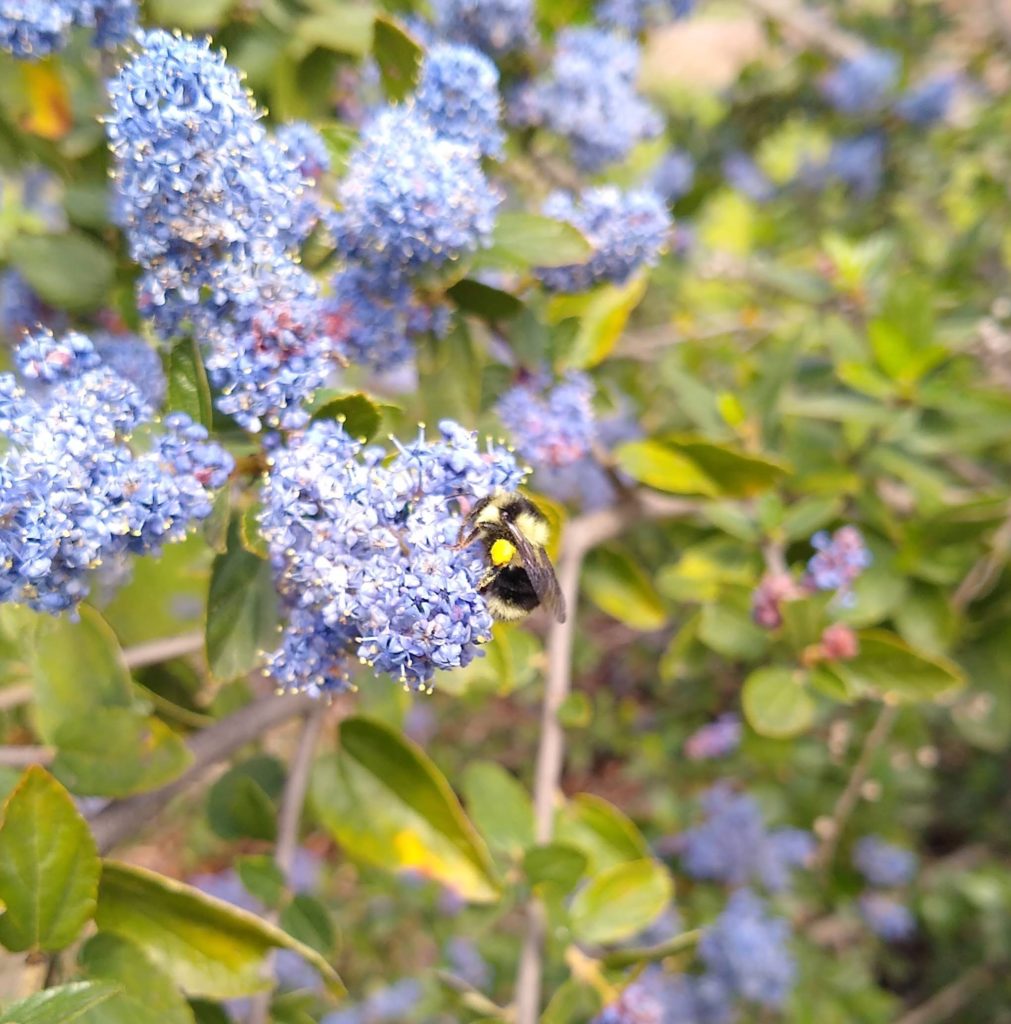
Starting own germplasm
Also because some of the plants are now mature, they’ve started reproducing and spreading. This winter, for example, I found three black sage seedlings and two monkey flower seedlings.
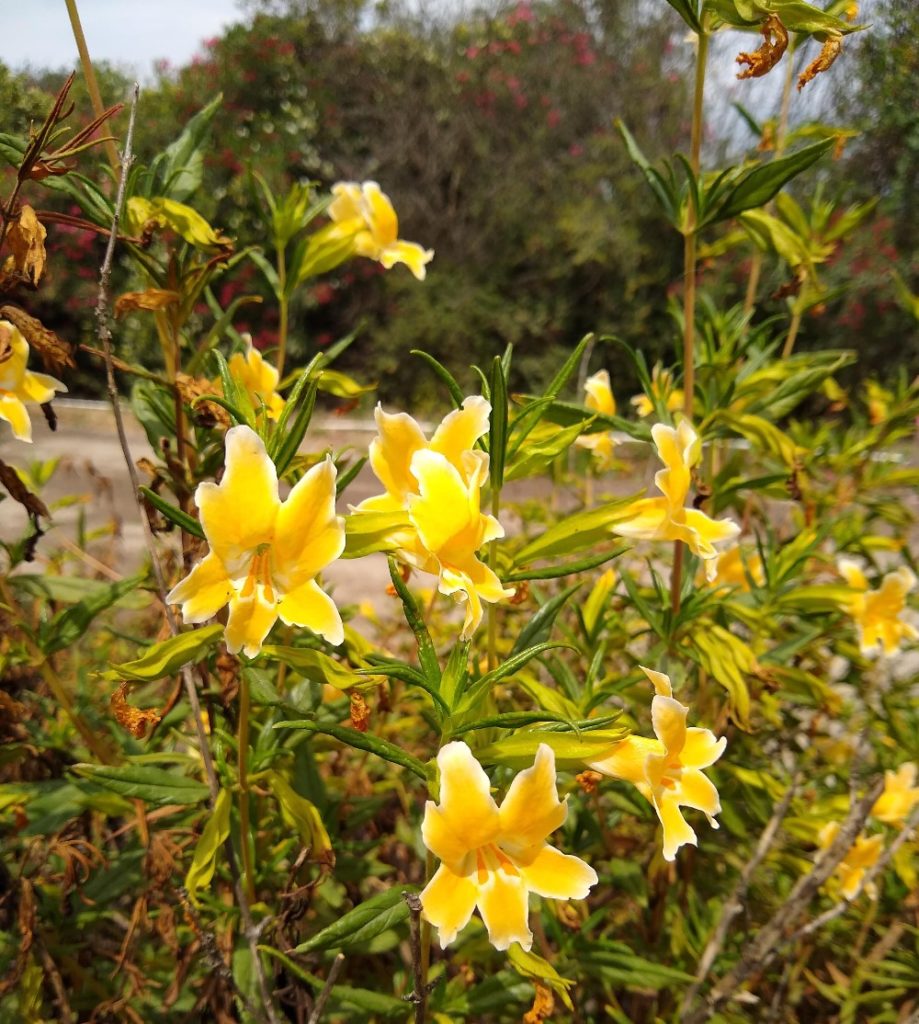
It feels like the roadside plant community will reach a point where it reproduces and spreads itself so well that my only job will be to contain it. That might be ten years down the line though.
Weeds
I have gotten away without using any herbicides to kill the weeds. When we moved in, tumbleweeds covered the area. I killed them with a shovel before they set seed, or if they’d already set seed I took them to the trash. One year of this made a big difference. In the second year, there were only a few tumbleweeds to deal with. I have not seen a single tumbleweed appear in a couple years now.
Another weed in that area is Bermuda grass. When planting, I dig up all the Bermuda grass within a few feet of the planting hole. Around a new plant I put a thick layer of woodchips. Eventually, the Bermuda grass invades those woodchips and grows near the new plant, but I pull it out every now and then — not digging down to get roots, but just removing the top growth.
This control has been enough to allow the plants to establish themselves. Once the plants grow big, they shade out the Bermuda grass and I no longer bother pulling it around such mature plants.
I do also mow the grass and other weeds a few times a year.
True natives
As I mentioned in previous posts, my hope was to restore the native vegetation that I thought might have grown along the road before it was bulldozed. In other words, I didn’t want to just plant “California natives” but rather plants that were truly native to my yard or neighborhood as best as I could determine.
This proved to be a task that my propagation skills weren’t matched for, unfortunately. I failed at growing so many plants that I chose to purchase and plant whatever was at least similar to those true natives.
For example, I bought and planted that ceanothus ‘South Coast Blue’ because my cuttings of ceanothus plants from my neighborhood failed.
But I’ve grown slightly more skilled, and some of my roadside hedge plants now are from my own cuttings, and some are from transplants, where I just dug up small plants in other parts of my yard or the neighborhood. I’ve yet to have much luck with seeds though.
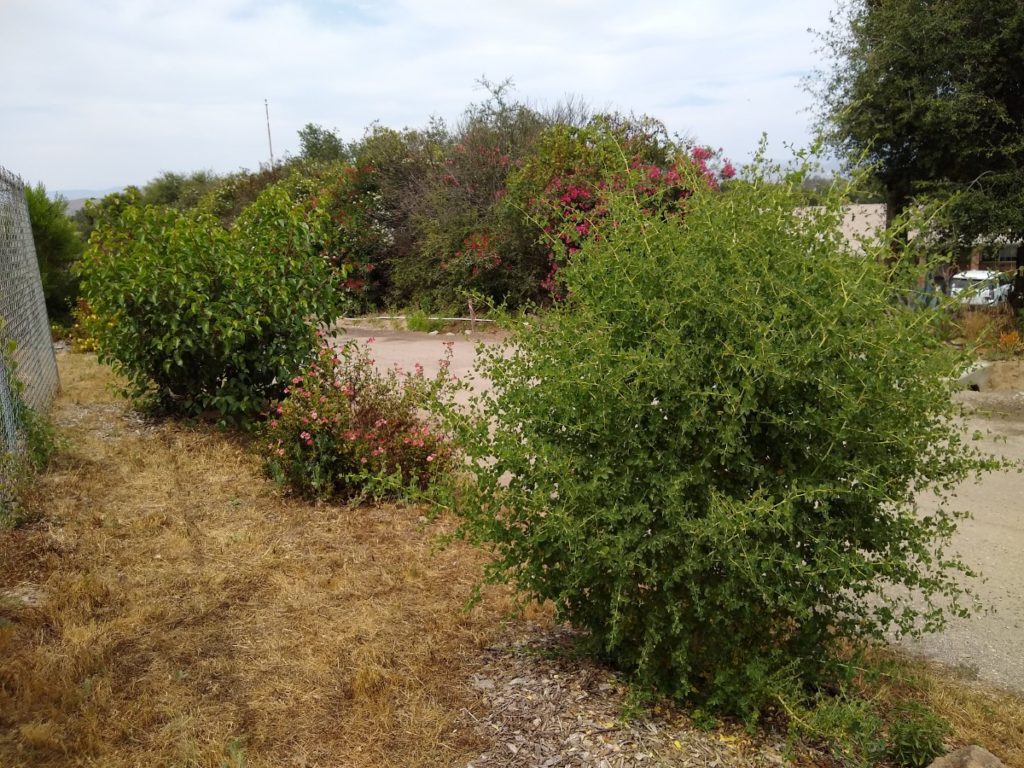
List of plants now
As of today, here are the plants that fill my roadside hedge of natives. The common name is in bold followed by the scientific name in italics in parentheses, and that is followed by where the plant came from.
Phacelia (Phacelia ramosissima or cicutaria or?)- transplants from other parts of my yard
Coastal sagebrush (Artemisia californica)- transplant from a friend’s yard nearby
Monkey flowers (Mimulus aurantiacus or Diplacus aurantiacas)- bought from Moosa Creek Nursery and transplanted seedlings of those mother plants
California lilac (Ceanothus leucodermis, Ceanothus ‘South Coast Blue’, Ceanothus ‘Ray Hartman’)- hybrids from Moosa Creek Nursery; leucodermis from neighbors’ yards
Scrub oaks (Quercus species?)- transplanted from other parts of my yard, and one from a neighbor
California buckwheat (Eriogonum fasciculatum)- transplanted from other parts of my yard
Deer weed (Acmispon glaber or Lotus scoparius)- appeared on its own, but it does grow in other parts of my yard
Manzanita (Arctostaphylos stanfordiana bakeri ‘Louis Edmunds’ and Arctostaphylos x ‘Austin Griffiths’)- bought from Moosa Creek Nursery
Black sage (Salvia mellifera)- bought from Moosa Creek Nursery, one started from cutting, and a couple seedlings transplanted
Coyote bush or brush (Baccharis pilularis)- started as cutting taken from plant in neighborhood
Sugar bush (Rhus ovata)- bought from Moosa Creek Nursery
Toyon (Heteromeles arbutifolia)- bought from Moosa Creek Nursery
Yellow bush penstemon (Keckiella antirrhinoides)- gift from neighbor
Blue elderberry (Sambucus cerulea or Sambucus nigra ssp. caerulea)- one started as cutting taken from plant in my neighborhood, one bought from Moosa Creek Nursery
And listen to this: After planting an elderberry down by the road a couple years ago that I’d grown from a cutting that I took from a plant in the neighborhood, just last year an elderberry sapling appeared on its own in another part of my yard, very far from the road.
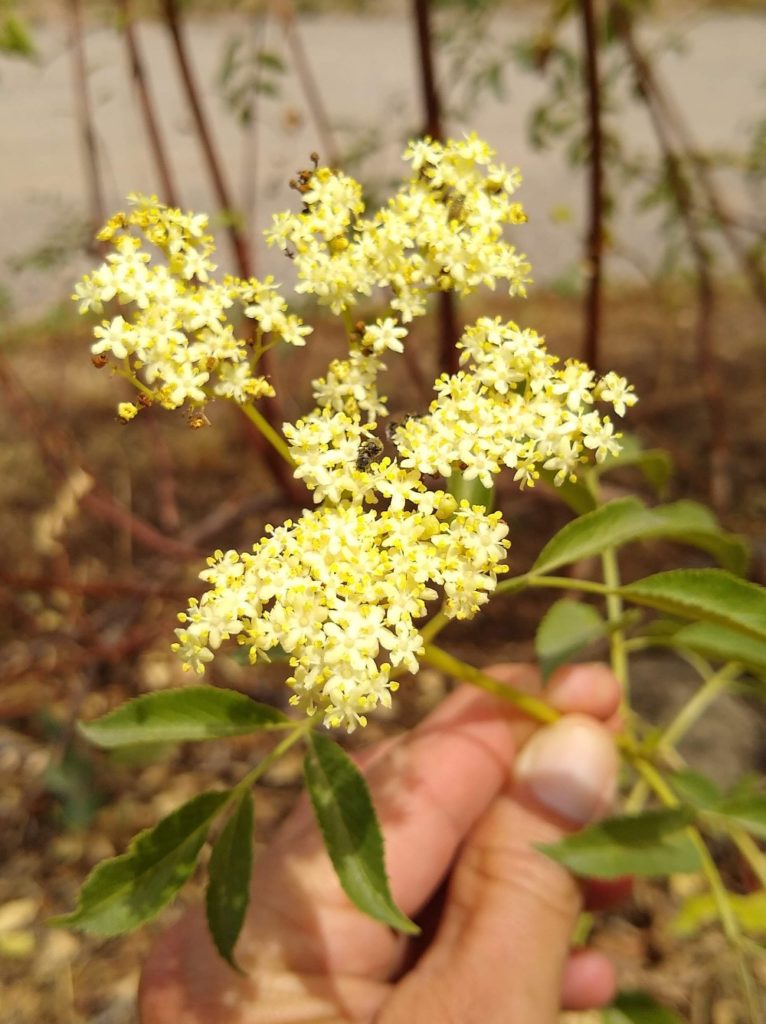
That made me confident that elderberries could have been growing wild by the road before the area was devegetated. I love feeling like I’m helping to restore native flora and fauna to surround my food garden.
A list with links to all of my Yard Posts is HERE.




I get to be the first to comment on this post. I had read post “Natives at the Roadside” not to long ago and it was still open in a tab in my browser. I was wondering if/when you would provide an update. Well here it is! Thanks for another informative post that’s fun to read.
Enjoyed reading about your success and failures and thank you for noting the plant names and where you got them. I find so often that failure is part of gardening, I feel that we plant in faith and hope and oh the joy when trees, flowers and gardens thrive.
Absolutely love this post (and all your posts Greg!) Especially the neighbor to neighbor sharing and habitat restoration you’ve got going on there! We are lucky to have the Theodore Payne Nursery over where I am, specialists in native CA plants – sales and education. (They are in Sunland, I’m in Glendale.) I have tons of natives in my own small patch of garden front and backyards – but the what is super wonderful right now, is that as the Green Team lead at Franklin Elementary here, I lead a team of volunteers, and the kids, to take care of a transformed campus that went from mostly asphalt to now all native CA plants, bioswhales and living fences. I have to say that the satisfaction I get from helping transform that 3 or so acres back to a native plant habitat is just so satisfying. Seeing the sages, toyons, ceanothus, buckwheat, coffee berry, lemonade berry, oaks, desert willows, sunflowers, hummingbird sage, milkweed, deer grass, mallows and on and on thriving (at least what isn’t stepped on my the little kids) and inviting the pollinators of all kinds is just beautiful. Both at home through my front window, and now all around the campus at the school – I see monarch butterflies and other butterflies and bees galore and song birds and hummingbirds and yes, our lizard friends all over – it’s just beautiful. Keep up the good work over there Greg! Avocado insight brought me to your pages originally – but am loving all the other food tips and now this – encouraging folks to put back the plants that were once all over CA. I’m learning all about the Native American’s medicinal uses for the plants too, and waiting for my elderberry to get big enough to grow some berries! About to try a foot soak with black sage or CA sage plus an avocado pit and 70% alcohol…let’s see if that helps some foot pain I’ve had of late. All kinds of magic to discover with these plants!
This is great to hear, Monica! I would love to see more schools do what you’ve done at Franklin Elementary. I should see how I can help at my son’s elementary school.
One of the next steps for me will be learning to use some of these native plants too — not just letting the animals use them. I’ve heard about the many uses for the plants, but it’s time to try it out for myself. I feel somewhat ashamed that I know how to use so many exotic plants but not the native plants that have surrounded me in the fields and hills my whole life in Southern California.
By the way, I’m familiar with your neighborhood because my grandparents grew up right there on Allen and Linden Avenues. I used to visit my great grandmother at her house there (built by my great-great grandfather).
Just a quick recommendation on using native plants – elderberry is one of the easiest and most delicious!
Elderberry syrup is excellent, and a folk cough syrup (also goes great on waffles/pancakes). Lots of easy recipes online for that. At its simplest, just some kind of sweetener (honey, simple syrup, etc) and reduced juice from the berries.
Another one that is less known in the US and SO good is elderflower syrup. Exquisitely floral in a way that not much else is, and so refreshing with some sparkling water. I like this recipe:
https://www.lilvienna.com/homemade-elderflower-syrup/
But there are many other versions, and all delicious.
You might still be able to get some flowers, though that season is almost over – time to gather berries soon!
Thank you, Joe. Can’t wait to try this.
You have a great selection of natives. I’ve found that natives are great at providing flowers for pollinators and have the added benefit of then providing food for the creatures that would otherwise only eat the things I’m growing. One of my neighbors is a biologist and identified a few of our natives and the most impressive are the coast live oak and the Catalina island cherry. The cherry isn’t a true native to this area but is very similar to the mainland cherry. It’s great as the birds attack it and mostly leave my stuff alone. It has an earthy cherry flavor with a very large pit. Every now and then a seedling pops up under it that I pull out; if you want one I’ll see about transplanting it and you can have it. Just let me know. Again, thank you for your great posts.
Thanks, Bob. I have found a similar plant growing in my yard, the holly-leaved cherry (Prunus ilicifolia). I’d love to add that to the roadside, but if I can’t I’d love to try one of your Catalina cherry seedlings.
Great to hear that you’ve noticed the birds being distracted by its fruit. I’ve hoped for this effect in the future, but figured it was probably unrealistic.
Greg,
Thank you again for very informative post on California native plants. My claim to natives so far is only a milkweed that I have grown in my yard from seeds given to me by my friend few years back. Milkweed is now successful in propagating itself in places one would not even expect. I see this success in many other plants in my garden, such as Larkspur, Rudbeckia Graciosa, Periwinkle, Sweet Alyssum, Pot Marigold, Melisa Officinalis, Dill, red beets and cherry tomatoes all of which I only transplant to places I want them to grow. They are now my yard natives.
The main advantage of these seed volunteers is their adaptation to my yard habitat. They may have come originally from as far places as Holland but their genetics have slowly been altered to better suit my yard micro-climate.
I love this approach, Paul. I also try to allow volunteers to grow wherever they pop up; you never know, you might discover an amazing strain that is perfectly suited to your yard, as you said.
So many of the varieties that we have today came from someone allowing volunteers to grow, not from professional breeders: the Reed avocado, many heirloom tomatoes and beans, etc.
Hey Greg, thanks for doing this! I’ve been eager for the update. As I mentioned in my comment to your last post on natives, I am also on this crusade but just starting. You mentioned your propagation difficulties. Any words of wisdom as to what works/doesn’t? I have bought lots of seeds from the San Diego chapter of CNPS, and collected lots, but I have a very difficult time getting from germination to strong seedlings. Seems they want to be tossed on the soil and forgotten about rather than babied. Cuttings are also more of a challenge, and I think the water requirements throw me off. My hope is to someday have lots to share with others. We are so lucky to live in the most biodiverse plant community of all US counties! Take care and thanks for this amazing education.
Hi Ben,
My main find with regard to cuttings has been to do them between December and February or so. I don’t have a greenhouse, nor do I have the time or irrigation set up to stay on top of the moisture requirements to propagate cuttings during warm parts of the year. I use no equipment at all. But if done in winter when the weather is mild and rainy, my cuttings often take care of themselves. I simply stick them in the ground, usually in the partial shade of a big plant and water them in if necessary and do nothing for them again. And some take.
Thanks for another great post Greg, I really appreciate having a local resource and have learned a lot from all of your writings!
I especially appreciate your mention here about your approach to bermuda grass. I have a horrible amount of this evil stuff all over my yard and of course it’s thriving most where I’m watering – next to all of my newly planted fruit trees and native plants. It’s been a struggle to deal with it – it’s hard work to get all the roots out, and seems impossible to completely eliminate.
You’ve given me hope that I can simply tear it out as it creeps into the root zone of my new plants, and eventually it will be kept at bay naturally as the plants establish themselves.
Thank you!
Hi Kathy,
Thanks for the feedback. Bermuda is indeed tough, but like all weeds, it does have its vulnerabilities. One weakness I appreciate about it is that it doesn’t produce viable seed (certain varieties don’t anyway, including the one in my yard). So at least it doesn’t spread that way too.
Very cool! Have you found any natives that do well as companions to fruit trees and in general closer in to irrigated areas of your garden?
Hi Steve,
I’ve found that smaller native plants work fine next to fruit trees or vegetables, but larger ones are too competitive for water. For example, I have poppies and phacelia and gilia flowers working well near many different fruit trees, as well as near my vegetables. But encelia californica and laurel sumac and ceanothus and buckwheat seem too big; they tap into the irrigation water I’m giving to the fruit trees or vegetables and suck away too much. You could probably make them all work together if you watered a ton though.